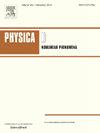SU(2)-Hidden symmetry of two-level media: Propagation of higher-order ultimately short-wave excitations with nonzero angular momenta
IF 2.7
3区 数学
Q1 MATHEMATICS, APPLIED
引用次数: 0
Abstract
Following the SU(2)-symmetry analysis, we perform a more detailed investigation of interaction of ultimately short-wave optical solitons with the two-level media within the viewpoint of propagation of higher-order waveguide excitations with nonzero angular momenta. As a result, we derive a new partial differential evolution model system expressed within the Hilbert space while describing the propagation of circularly polarized optical waveguide excitations. Accordingly, we solve the previous Hamiltonian system and address the expression of the one-soliton solution. We hence depict its spectrum which shows the distribution of the wave-frequency for circular polarization with a pulse-profile. Besides, investigating the variations of the electric field of the medium with respect to the population inversion integral, we discuss some typical features which profiles strongly depend upon the wave-frequency of the carrier. Accordingly, we pay particular interests to the ultimately short waveguide excitations while studying their interactions through the two-wave and three-wave depictions, and their shifts characterizing their nonlinear and rotating scattering features. As a result, we find that such features actually represent the elastic interactions between individual wave structures with the soliton properties arising from the interplay between the nonlinearity and the dispersion. We address some physical implications of the results obtained previously.
求助全文
约1分钟内获得全文
求助全文
来源期刊

Physica D: Nonlinear Phenomena
物理-物理:数学物理
CiteScore
7.30
自引率
7.50%
发文量
213
审稿时长
65 days
期刊介绍:
Physica D (Nonlinear Phenomena) publishes research and review articles reporting on experimental and theoretical works, techniques and ideas that advance the understanding of nonlinear phenomena. Topics encompass wave motion in physical, chemical and biological systems; physical or biological phenomena governed by nonlinear field equations, including hydrodynamics and turbulence; pattern formation and cooperative phenomena; instability, bifurcations, chaos, and space-time disorder; integrable/Hamiltonian systems; asymptotic analysis and, more generally, mathematical methods for nonlinear systems.
 求助内容:
求助内容: 应助结果提醒方式:
应助结果提醒方式:


